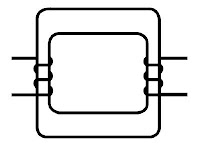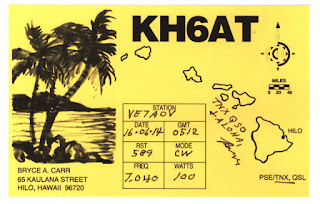Posts Tagged ‘RFI’
 Recent Noise Mystery Solved
Recent Noise Mystery Solved
Perhaps others can help explain something odd that I have just noticed with my Perseus while comparing antennas.
I was comparing signal levels and noise between a 40m half sloper and a very high dual 40/80m pair of inverted-V dipoles fed from a common feedline. Both the sloper and the dipoles are fed with 50 ohm cable and all three antennas are well matched at the low end of the band(s).
Listening to a 6 MHz signal from China National Radio around 10 am today, the signal was around S7-8 on the Perseus, using the 40m sloper. Listening to the same signal, at the same time, on the Yaesu FT-1000mp, with the high inverted-V, it was slightly better, maybe by 5-6 db and overall lower noise. I then put the inverted-V onto the Perseus and there was not even a trace of the signal! I made this check with several signals and always with the same result.
Now I suspect that the SWR of the 7MHz inverted-V when used at 6MHz, is very high and the load presented to the Perseus antenna input is likely highly reactive and far from 50 ohms but that doesn't seem to bother the FT-1000.
I then ran the inverted-V through my antenna tuner so that it effectively produced a 50 ohm non-reactive input load for the Perseus and did the tests again...with the same results. Swapping antennas for the 40m sloper once again produced the same signal levels in both the Perseus and the FT-1000.
So what is going on here and why does the Perseus balk at the 7 MHz inverted-V while listening on 6 MHz? Is there something in the Perseus front-end analog filtering system that is overly sensitive even though the reactance was tuned out via the tuner? Is it the 80m V on the same feedline as the 40m V that is causing some still unwanted reactance that is not tuned out with the tuner?
Any ideas what is happening here as it looks like I will not be able to use the inverted-V antennas on the Perseus for general SWL out-of-band listening for some, as yet unknown, reason.
As you can see, I was completely mystified by what I was hearing, or rather not hearing, and as it turned out, completely off the mark.
I received a few replies offering some possible reasons for what I was seeing but none of them proved helpful in solving my dilemma ... until Roelof Bakker (PAØRDT) weighed-in! Roelof suggested that I look at the antenna's performance while running Perseus's built-in 'HFSpan' function.
HFSpan is a stand-alone 0-40MHz spectrum analyzer, that comes with the Perseus software. Although I was aware of it, I have only used it sparingly. I next did some screen captures with all three antennas, one at a time, and sent them to Roelof.
His analysis did not take long as he immediately identified my problem ... a very high noise floor when using the mysteriously-performing inverted-V. Roelof suggested some common mode choking to eliminate the problem.
Already having an isolating transformer in hand from a previous experiment, I inserted it directly at the Perseus antenna input and looked at the noise floor again, around 40m. The transformer was wound on a small FT87-J core with a 3 turn primary directly opposite a 3 turn secondary. I was astounded to see the background noise floor drop from -85dbm to a very quiet -110dbm!
Evidently there was a lot of noise being picked-up on the inverted-V's feedline shield. Not hearing any of this noise on the FT-1000 indicated that the noise was probably associated with the Perseus power supply, the laptop or the laptop's power supply. This immediately explained why I wasn't hearing anything with this antenna when used with the Perseus.
Roelof then suggested that a 2 turn / 2 turn transformer, offering less inter-winding capacitive coupling, might provide even more isolation ... and he was right again. A further ~4dbm lowering of the ambient noise was measured.
| It may not be pretty but it produced an astounding improvement! |
Further comparisons between the FT-1000 and the Perseus revealed that the FT-1000 was still producing a slightly better SNR than the Perseus, when using the inverted-V so evidently there was still some noise affecting the signal. I had a few very large #43 ferrite toroids and decided to wrap a few turns (5) of the RG8-X feedline around the toroid to see if there would be any improvement.
Once again, using HFSpan, I compared the noise floor both with and without the #43 choke and saw a further 6-7 dbm improvement! Going back to comparing SNRs between the FT-1000 and the Perseus, I now saw no difference between how I was hearing on both receivers, when using the troublesome inverted-V ... eureka!
 |
| Same sweep, noise eliminated, signals now unmasked |
As of yet, I have not determined the actual noise source. I suspected it may have been coming from the Perseus power supply or from the laptop supply but that was not the case. Perhaps it is coming from the laptop's processor via the USB cable which I will also choke and see if HFSpan reveals anything further
This problem was a great learning experience for me, in more ways than one and I am most grateful to Roelof for his detective work and experience with noise issues and for taking the time to respond to my initial inquiry. Hopefully you may find something here that can help you as well.
 Trouble Free HF Antenna For The Apartment Dwelling Ham
Trouble Free HF Antenna For The Apartment Dwelling Ham
 Unfortunately we all know of or hear about hams that have given up all hope of getting on the air, once moving into an apartment or condo, where antennas are normally prohibited. One enterprising local amateur has combined early established antenna fundamentals along with sound engineering, to arrive at an elegant and highly successful solution. If you are also a 'location challenged' amateur, it may just be the thing that will help you, and others, take back your hobby and get on the air!
Unfortunately we all know of or hear about hams that have given up all hope of getting on the air, once moving into an apartment or condo, where antennas are normally prohibited. One enterprising local amateur has combined early established antenna fundamentals along with sound engineering, to arrive at an elegant and highly successful solution. If you are also a 'location challenged' amateur, it may just be the thing that will help you, and others, take back your hobby and get on the air!John, VE7AOV, has been operating from his apartment, in the heart of the very large and noisy greater Vancouver, for several years now ... not simply 'operating', but thriving, from his cozy fourth-floor apartment radio station. The wallpaper shown below would not usually be expected to grace the shack walls where antennas are not permitted!
It's soon apparent that John has also overcome the usual problem of noise ingression, from every appliance and random RFI generator in the complex. This is no lucky fluke but all by design, and delivered via an all but invisible classic antenna system made of #26 wire and a few Starbuck's stir-sticks!
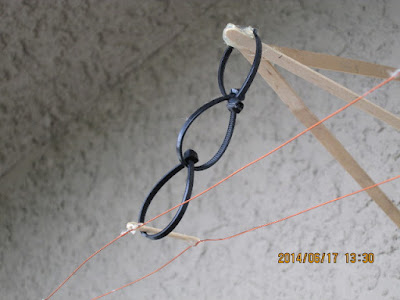 |
| 600 ohm #26 balanced line |
I'll let John tell you a bit more before sending you to his fascinating website, Intuitive Electronics, where you can learn more about his system and the engineering behind his successful, low-noise installation.
When it comes to a high frequency ham station, the antenna alternative chosen by most apartment dwellers is no antenna at all. The design here is a wisp of an antenna that bothers no one and which can work Japan, Australia, France, European and Asian Russia, the Caribbean, Central America, Polynesia and South America from the Pacific coast of Canada. It is a simple solution for apartment dwellers, it is a cheap solution and it causes no t.v.i. or other r.f. problems. It is far preferable to the alternative selected by so many fellow apartment dwellers: no antenna at all.
An implication that it seems to be impossible to rid from the minds of fellows using a Marconi antenna is that they are not just pumping 100 watts of r.f. into their antenna but that they are also pumping that same 100 watts of r.f. into their ground, that is to say the building’s wiring, the safety ground wiring. R.f. in the safety ground is well coupled into the power and neutral conductors of a residence and, in North American code, is even hard connected to the neutral line at the service entrance. The house wiring becomes part of the antenna system.
The ground wiring and everything connected to it is every bit as much a part of the antenna as is the live element. Both radiate just the same amount of r.f. power, fellows. The ground wiring along with every electrical power consumer in the building is worked against the live element. Thinking of what is connected to ground in your house is thinking about one side of your antenna. It’s not just appliances that get the “benefit” of r.f. The land line telephone system, the cable television system, the garage door opener, the security lights and…you name it. They are all “feeling” that 100W of r.f. With regard to r.f., there is no distinction whatsoever to be made between “hot” and “ground”.
You know the reason why vertical antennas have gained a reputation for being noisy on receive now, too. Most verticals are Marconi antennas. Both the safety ground and the neutral serve all the houses in the neighbourhood. The receiver is wired into the electrical appliances of the entire neighbourhood.
This radio station, located four stories above grade and in a wooden building full of apartments would be a worst case for r.f. in “ground”. This station has no r.f. in the station. It has no r.f. in “ground”.
The station has no interference issues. The Building Manager, the Building Superintendent and the administrator for this building’s cablevision have been aware of the station from the beginning. There has not been a single complaint of t.v.i. or any other complaint about the station. That’s a clean record extending back to 2006. There are no red faced, spluttering tenants hammering on the door of this station! At this station, all the r.f. produced by the transmitter makes its appearance out on the antenna. The radio station’s r.f. is not referenced to station ground. Station ground “knows nothing” about the r.f. being generated.
In the present case, that is to say a station to be operated in an apartment building, it is required to have an antenna that is “invisible”. Now it’s not possible to achieve that literally but at least the antenna should be so inconsiderable that there will be no complaints from neighbours about having to look at it. The antenna here is made of #26 A.W.G. wire. That’s wire that is 0.40mm, 0.016 of an inch, in diameter. Four stories up, it’s difficult to see the antenna and that’s even when knowing where to look for it. Part of the antenna’s run is through trees and in among the tree branches it pretty much is invisible. It does not annoy neighbours by casting a shadow; there is no shadow.
In spite if the naysayers, John's small gauge antenna has survived years of winter storms, regular occurrences here on Canada's western edge ... simply because it presents such a low cross-section compared to most conventional antenna wires.
To read more about enjoying your hobby again from your new 'restricted' location and more than likely, learn something new about old fundamentals, give John's website a very close inspection ... there is much wisdom and many gems to be found, even if you don't live in an apartment!
 Radio Frequency Interference From 12V-to-USB Adapters
Radio Frequency Interference From 12V-to-USB Adapters
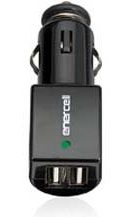 Many small electronic devices have switching regulators in them that can generate a bunch of Radio Frequency Interference (RFI). This is not my first encounter with RFI-spewing devices. See this article about a automotive 12V-to-USB adapter giving me trouble: This Interference Seems To Follow Me Everywhere
Many small electronic devices have switching regulators in them that can generate a bunch of Radio Frequency Interference (RFI). This is not my first encounter with RFI-spewing devices. See this article about a automotive 12V-to-USB adapter giving me trouble: This Interference Seems To Follow Me Everywhere
I recently bought a couple of adapters that are physically larger than the one I wrote about. I was thinking that a larger size might allow for a little more filtering and a design that does not radiate. I was half right: one of them works pretty well, the other is an RFI Bad Boy.
Take a look at this short video where I check them out.
This is an Amazon link to the adapter that works pretty well.
Enercell® 2-Port USB CLA Car Charger
73, Bob K0NR
The post Radio Frequency Interference From 12V-to-USB Adapters appeared first on The KØNR Radio Site.
 RFI … Radio Spectrum’s Global Warming?
RFI … Radio Spectrum’s Global Warming?
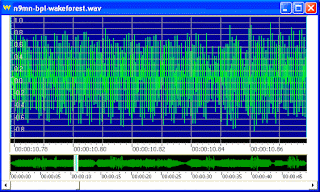 |
| courtesy: http://www.arrl.org/utilities |
The FCC's recent publication of an Order and Consent Decree (DA-17-471) has me wondering if this action signals new interest in cracking-down on those who manufacture and distribute unapproved spectrum polluting noise-generating devices or is it just a once-in-awhile muscle flex with little change in overall policy ... hopefully it's the former!
Highlights of the agreed upon notice:
Section 302 of the Act authorizes the Commission to promulgate reasonable regulations to minimize harmful interference by equipment that emits radio frequency energy....Specifically....that “[n]o person shall manufacture, import, sell, offer for sale, or ship devices or home electronic equipment and systems, or use devices, which fail to comply with regulations....
.... the Commission establishes technical requirements for transmitters and other equipment to minimize their potential for causing interference to authorized radio services ... the Commission administers an equipment authorization program to ensure that equipment reaching the market in the
United States complies with the technical and administrative requirements set forth in the Commission’s rules. The equipment authorization program requires, among other things, that radio frequency devices must be tested for compliance with the applicable technical requirements in accordance with one of three authorization procedures—i.e., certification, Declaration of Conformity, or verification—prior to marketing.
... the Rules prohibits the marketing of radio frequency devices unless the device has first been properly authorized, identified, and labeled in accordance with the Rules ...
... a privately-held company that manufactures and distributes lighting fixtures that are used in residential and commercial properties ... under-cabinet LED light fixtures were reportedly causing interference to AM/FM radio transmissions.
During the course of the investigation, the evidence revealed that ... the LED light fixtures were not tested and authorized under the Commission’s equipment authorization rules prior to marketing.
... the Bureau’s Spectrum Enforcement Division issued a Letter of Inquiry (LOI) ... directing to submit a sworn written response to a series of questions relating to ... the marketing of its LED lighting fixtures in the United States.
... continued to market the light fixtures at issue for certain times during an approximately five-month period after receipt of the LOI.
Other highlights indicate that the company in question acknowledged their violation and agreed to appoint a Compliance Officer in charge of implementing new company protocols, including the retraining and education of employees dealing with compliance issues. As well, a $90,000 civil penalty was imposed on the company for the violation.
As a point of interest, I can't ever recall seeing similar notifications being released or reported here in Canada by our FCC equivalent, the ISEDC. Hopefully they also take similar actions, but if so, they don't seem to be reporting it ... perhaps I'm just not looking in the proper places.
As I've mentioned here previously, for too many radio amateurs, the growing noise floor throughout the radio spectrum has become a global threat for the healthy pursuit of our hobby. Even if we saw the immediate implementation of rigorous new tight standards, crackdowns and prosecutions of offenders, it may already be too late to reverse the damage we are now seeing ... in many respects, it's the 'global warming' of the RF spectrum and there may be no turning back without immediate action.
 RFI … Radio Spectrum’s Global Warming?
RFI … Radio Spectrum’s Global Warming?
 |
| courtesy: http://www.arrl.org/utilities |
The FCC's recent publication of an Order and Consent Decree (DA-17-471) has me wondering if this action signals new interest in cracking-down on those who manufacture and distribute unapproved spectrum polluting noise-generating devices or is it just a once-in-awhile muscle flex with little change in overall policy ... hopefully it's the former!
Highlights of the agreed upon notice:
Section 302 of the Act authorizes the Commission to promulgate reasonable regulations to minimize harmful interference by equipment that emits radio frequency energy....Specifically....that “[n]o person shall manufacture, import, sell, offer for sale, or ship devices or home electronic equipment and systems, or use devices, which fail to comply with regulations....
.... the Commission establishes technical requirements for transmitters and other equipment to minimize their potential for causing interference to authorized radio services ... the Commission administers an equipment authorization program to ensure that equipment reaching the market in the
United States complies with the technical and administrative requirements set forth in the Commission’s rules. The equipment authorization program requires, among other things, that radio frequency devices must be tested for compliance with the applicable technical requirements in accordance with one of three authorization procedures—i.e., certification, Declaration of Conformity, or verification—prior to marketing.
... the Rules prohibits the marketing of radio frequency devices unless the device has first been properly authorized, identified, and labeled in accordance with the Rules ...
... a privately-held company that manufactures and distributes lighting fixtures that are used in residential and commercial properties ... under-cabinet LED light fixtures were reportedly causing interference to AM/FM radio transmissions.
During the course of the investigation, the evidence revealed that ... the LED light fixtures were not tested and authorized under the Commission’s equipment authorization rules prior to marketing.
... the Bureau’s Spectrum Enforcement Division issued a Letter of Inquiry (LOI) ... directing to submit a sworn written response to a series of questions relating to ... the marketing of its LED lighting fixtures in the United States.
... continued to market the light fixtures at issue for certain times during an approximately five-month period after receipt of the LOI.
Other highlights indicate that the company in question acknowledged their violation and agreed to appoint a Compliance Officer in charge of implementing new company protocols, including the retraining and education of employees dealing with compliance issues. As well, a $90,000 civil penalty was imposed on the company for the violation.
As a point of interest, I can't ever recall seeing similar notifications being released or reported here in Canada by our FCC equivalent, the ISEDC. Hopefully they also take similar actions, but if so, they don't seem to be reporting it ... perhaps I'm just not looking in the proper places.
As I've mentioned here previously, for too many radio amateurs, the growing noise floor throughout the radio spectrum has become a global threat for the healthy pursuit of our hobby. Even if we saw the immediate implementation of rigorous new tight standards, crackdowns and prosecutions of offenders, it may already be too late to reverse the damage we are now seeing ... in many respects, it's the 'global warming' of the RF spectrum and there may be no turning back without immediate action.
